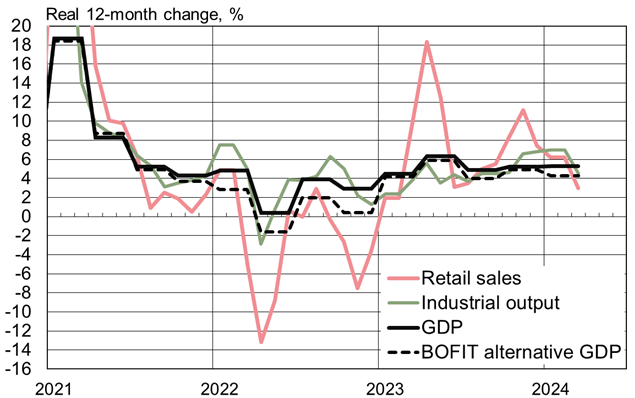Official is 5.3% y/y (consensus 4.8%), vs BOFIT 4.3%.
Source: BOFIT (2024).
The BOFIT alternative is based on reported nominal GDP and using alternative price deflator.
The Fernald-Hsu-Spiegel CCAT is not yet available for Q1. As of 2023Q4, CCAT y/y deviation from trend was slightly above official GDP.

Judging from the latest absurdity Ala Princeton Stve may there is a measure that shows Gdp fell by 80 percent
Here’s a longer look at China’s GDP:
https://en.macromicro.me/collections/22/cn-gdp-relative/224/cn-gdp-growth-rate
Dragging a trend line across a graph is hardly scientific, but it does seem that growth in the past few quarters, after a period of Covid-induced volatility, is right about on trend. China’s growth was slowing (and suspiciously smooth) throughout Xi’s rule prior to Covid, and is still slowing.
With all the strains on China’s economy, it is reasonable to expect growth will continue to slow, allowing for some cyclical variation. Local government bookkeeping yonder Xi aims at obscuring variation, but the trend seems to remain in place.
The FTC has votes to ban labor non-compete agreements, and has required firms to inform all employees except senior execs that existing non-compete agreements will not be enforced.
This is good news for a handful of reasons. It reduces employers power over employees. It allows greater labor turnover within industries, which should lead directly to improved labor efficiency. Higher wages provide an incentive to capital investment, which should also lead to improved labor efficiency. It’s in keeping with the U.S. legal tradition of the free movement of labor. And it’s just the right thing to do.
Kevin Drum noted at his blog
Off topic – solar power:
California has a “problem” with solar power – too much?:
https://www.washingtonpost.com/us-policy/2022/09/21/california-is-awash-renewable-energy-except-when-its-most-needed/
C’mon. This is just journamalism – anything that isn’t a problem isn’t news. The scale of solar power generation in California is news, so it must be a problem.
We were once promised that nuclear power would mean electricity would be practically free. Now that solar power is doing just that, WaPo treats it like a bad thing. Can we just for a moment wrap our heads around the fact that transition requires, well, it requires transition. Things have to change and change is bumpy. Free electricity, every once in a while, for goodness sake.
I noticed this is about a year and a half old. I think they have still not been washed into the sea by that flood of excess solar energy. I have not since heard of negative solar energy prices so I guess they found a way to solve the “problem”.
An interesting article in NYT on a “glut” of car factories in China. The shift away from ICE towards EV and a general slowing of vehicle purchasing has left a lot of capacity not being used.
https://www.nytimes.com/2024/04/23/business/china-auto-factories-price-cuts.html
The subsidy system prevent the obviously more efficient conversion of old Ice factories to EV factories.
“Almost all of China’s electric cars are assembled at newly built factories, which qualify for subsidies from municipal governments and state-directed banks. It’s cheaper for automakers to build new factories than to convert existing ones. The result has been enormous overcapacity”.
The record speed of conversion to EVs in China may end up costing a lot of jobs:
“Cities that are particularly dependent on gasoline-powered car production, like Chongqing, face a jobs dilemma. Assembling electric vehicles requires considerably fewer workers than making gasoline-powered cars, because E.V.s have much fewer components”